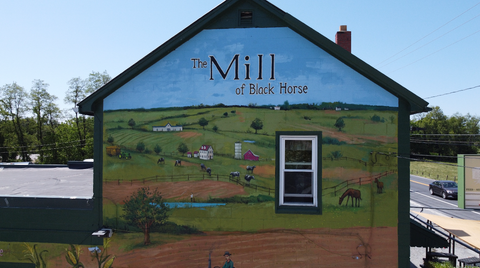This week, our very own Ben Hushon, Certified Crop Advisor and Head of Agronomy at The Mill, joined RFD-TV's Market Day Report to talk about what he’s seeing in corn fields across Maryland and Southern Pennsylvania—and what might be one of the more unusual growing seasons in recent memory.
As we move through a critical window in the corn reproduction cycle, Ben broke down what’s happening in the field in a way only he can—scientific, practical, and with a dash of humor. Here’s a closer look at what he shared during the segment.
Nature’s Timing: Tassels and Silks
If you’ve ever pulled back the husk of an ear of sweet corn and found yourself wrestling with all those silky strands, you might not know you were holding a biological marvel. Each of those silks is essentially an umbilical cord that connects to a potential kernel of corn. On average, each ear has around 1,000 silks—and each one needs a pollen grain to produce a kernel.
That pollen comes from the tassel, which appears at the top of the corn plant. A single tassel can release as many as 2 million grains of pollen, and for successful pollination, that pollen has to land on a silk during a very specific window.
Usually, the appearance of tassels and silks is perfectly timed. But this year, something strange is happening.
Unusual Tassel Development
In parts of our region—primarily Maryland and Southern Pennsylvania—Ben and the agronomy team have noticed tassels that are wrapped tightly and failing to fully emerge. This kind of delay disrupts the natural synchronization between tassel and silk development.
The result? Silk that just keeps coming.
In Ben’s words: “Mother Nature is saying, ‘Where’s that pollen?’ and keeps pumping out more and more silk in an attempt to catch some.” Unfortunately, while the effort is impressive, silks (and pollen) are only viable for a short window. If they miss each other, kernel development suffers.
In some cases, Ben reported ears with as little as 30% pollination. That’s a serious drop from what’s typical during a healthy growing season.

Is It Widespread?
While these pollination issues appear to be limited in scope in our immediate area so far, Ben mentioned hearing reports of similar issues stretching as far west as Kansas. So, while not catastrophic, this is a trend that growers across multiple states are watching closely.
Ben's field photos showed silks that were two to three times longer than usual—a clear signal from the plant that it’s struggling to catch pollen. Fortunately, not all fields are affected, and many still show strong pollination progress.
What Does This Mean for Growers?
First and foremost, it means continued scouting is critical. Understanding the extent of the issue in your fields now will help you plan for harvest expectations and post-season evaluations.
If you’re unsure about what to look for, our agronomy team at The Mill is happy to help. Bring in photos or samples, or email to the agronomy team, and we’ll walk you through how to assess pollination success and potential yield impact.
And if you’re outside of Maryland and Southern Pennsylvania and noticing similar tassel/silk mismatches, it’s worth checking in with your local crop advisor. The more we all share, the better we can respond to shifting weather patterns and growing conditions.
Final Thoughts: A Reminder of Nature’s Complexity
Despite decades of research and innovation, every season still reminds us just how delicate the crop development process can be. From perfect timing between tassel and silk, to getting just the right amount of rain—agriculture remains a dance with nature.
As Ben said during the interview, “It’s pretty simple… but also pretty amazing.”
Stay tuned to our blog and social channels for more crop updates and educational insights from the field. And don’t hesitate to reach out to The Mill team if you have questions about your fields—we’re always here to support our growers and the land they work so hard to care for.
























